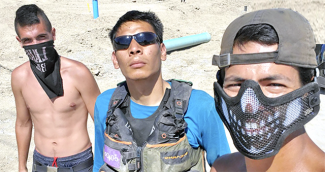LAND HUSTLE
Indigenous activists fight to keep and reclaim treaty lands

Activists at 1492 Land Back blockade in Caledonia, Ontario
WHOSE LAND IS IT ANYWAY? Indigenous activists in Caledonia, Ontario have removed their blockades, but the question remains unanswered.
Activists built the blockades to protest the construction of houses on treaty lands of the Haudenosaunee (Six Nations) Confederacy. The Haudenosaunee Confederacy Chiefs Council opposes the development and supported the blockade and activists encampment.
Indigenous land disputes in Caledonia have simmered for more than a decade. This time around, the encampment, named 1492 Land Back Lane was established on July 19. It is located at the site where a developer intends to build 218 homes on 25 acres.
One hundred Ontario Provincial Police officers swooped in to dismantle the camp and arrest nine activists on August 5. Once most of the police had left, the protesters, bolstered by other Six Nations supporters, reclaimed the piece of land.
The federal minister of Crown–Indigenous Relations has asked for a meeting with the two Indigenous factions at odds in the dispute.
Indigenous sovereignty key
The Haldimand deal was made eighty-four years before Band Councils, or the Canadian Government, existed. It was a deal between the Haudenosaunee Hereditary Chiefs Council, and the British Government. Just like the conflict between Wet’suwet’en Hereditary Chiefs and Coast Gas Link, the unrest at Six Nations, while sparked by the Mackenzie Meadows development is at its core about Indigenous Sovereignty, the right of First Nations to make decisions for themselves, using their own government.
Band councils: the on-reserve arm of federal government
The Six Nations Elected Council is a Band Council, an elected administrative body that governs the Six Nations reserve. This sounds great, but, the model for Band Councils is outlined and enforced by the Canadian government through the Indian Act, a piece of legislation with the stated purpose of controlling and assimilating Indigenous People.
In addition to enforcing the Band Council government system on reserves, the Indian Act has been used to enforce a series of rules designed to disempower First Nations, including; the residential school system, blocking on-reserve economic activity like commercial farming, taking Indian Status away from women who marry men from outside of their community, and more.
While today, Band Councils are elected by Band Members, when the Indian Act was first administered, government officials called, “Indian Agents” would appoint Band Council leadership and influenced many of its decisions. Because Band Councils are historically the on-reserve arm of the Federal Government, many Band Members do not trust, or vote in Band Council elections, and prefer to turn to the pre-Indian Act leadership established by their community.
The developer in the Caledonia dispute used this dual reality to claim Indigenous approval by cutting a deal with the band council that included the transfer of 42.3 acres of land and $352,000 to the Six Nations Elected Council.
Who are Six Nations?
Six Nations, also known as Haudenosaunne or Iroqouis, are a confederacy of nations who have traditionally lived in around the Great Lakes in what’s now known as Upstate New York, Quebec and Ontario. Like their English name says, the Haudenosaunee Confederacy is made up of six distinct Nations; Mohawk, Oneida, Cayuga, Seneca, Onedaga and Tuscarora.
Today, there are several federal reserves across Quebec, Ontario and New York designated for members of the Haudenosaunee Confederacy. The Six Nations of the Grand River reserve is one of the few reserves where members of all six nations of the confederacy live together. This is because the Six Nations reserve was once much bigger than it is today.
The Haldimand Tract
The Haudenosaunee were British Allies in the American Revolution, and in 1784, as payment for their support, the Governor of Quebec, Sir Frederick Haldimand, granted the Haudenosaunee Confederacy the land 10 KM deep on either side of the Grand River in South-Western Ontario. This deal became known as the Haldimand Proclamation.
The Haudenosaunee Confederacy entered this deal as equal allies to the British and believed they would live peacefully as a sovereign nation along the Grand River. The British on the other hand, despite needing them during war, considered the Haudenosaunee subjects of the Crown.
Continuous land disputes
In the 236 years since this deal was made, Six Nations land sovereignty has been repeatedly undermined, ignored and denied. Six Nations territory continues to shrink due to unlawful sale or seizure permitted or engineered by the governments of Ontario and Canada.
It’s all part of a colossal land hustle: one that extracted huge giveaways from Indigenous people in return for guarantees of permanent sovereignty over land reserves; guarantees that government after government casually ignored, to allow developers to grab treaty lands that were supposed to be Indigenous, and Indigenous alone forever.
In 1974, The Six Nations Land Claims Research Office (SNLCRO), was established to work in the Canadian legal system to get Six Nation’s land returned to the community. Since its creation, the SNLCRO has made 29 separate land claims to the federal government. Only one has been resolved, the Federal Government hasn’t engaged with the unresolved claims since 1995.
In 2006, Caledonia sold and attempted to build a subdivision called Douglas Creek in an area known as Kanonhstaton, “the Protected Place”. In February 2006, Land Defenders began to blockade Highway 6, in opposition to the housing development. In June 2006, due to the months-long backlash from the community, Ontario purchased the land from developers. The land remains in dispute.
Both Kanonhstaton and 1492 Landback Lane are included in the remaining 28 unresolved Six Nations land claims.
Despite the court date to resolve Six Nation’s remaining land claims set for 2022, The Crown unlawfully sold 200 acres of disputed land near Caledonia to Toronto-based development company, Ballantry homes for the purpose of building the Mackenzie Meadows Subdivision.
- 30 -
Support
You can support Six Nations land claim to Landback Lane by signing this petition, emailing your representatives using this link, and joining the occupation in Caledonia by visiting the Landback Lane Facebook group.
Sources:
https://www.nps.gov/fost/learn/historyculture/treaties-intro.htm
https://en.wikipedia.org/wiki/Iroquois
https://www.thecanadianencyclopedia.ca/en/article/iroquois













Add new comment